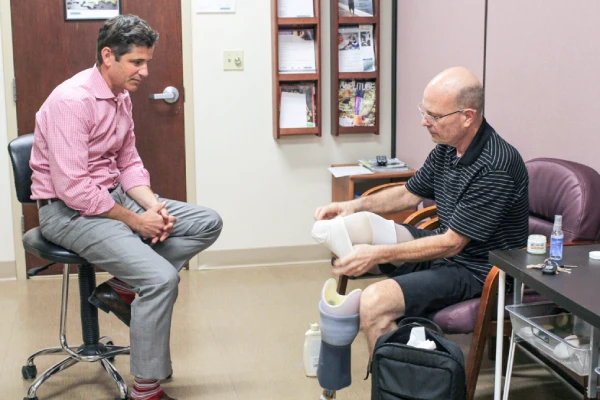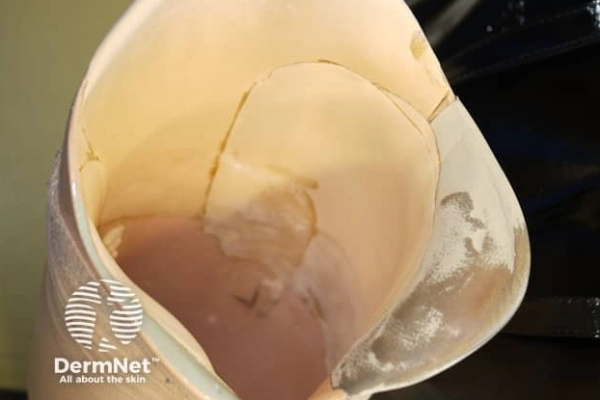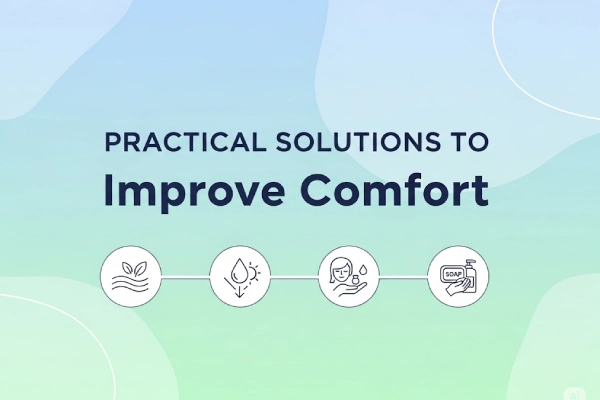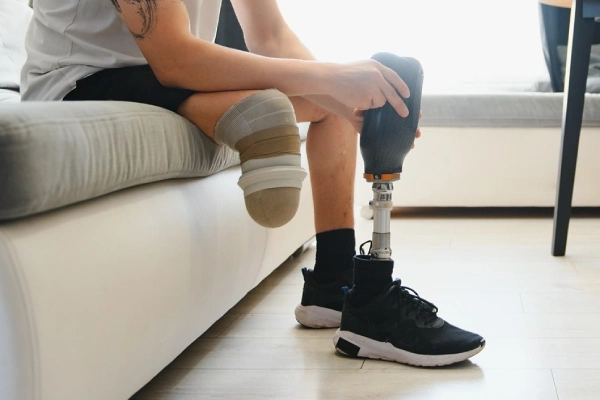
“Every time I take off my prosthetic, my stump sock is damp, and my skin feels itchy or irritated.”
If this sounds familiar, you’re not alone. Many prosthetic users experience sweating or itching when wearing a stump sock, especially during warm weather or long periods of use. While some moisture and mild irritation are normal, persistent discomfort can often be reduced—or even prevented—by identifying the cause and making small adjustments.
In this guide, we’ll break down the most common reasons for sweat and itch, and share practical, medically backed solutions to help you stay comfortable throughout the day.
Common Causes of Sweating or Itching

Low Breathability
If the fabric traps heat and moisture, the stump remains damp. Materials without ventilation channels or moisture-wicking properties make the problem worse, especially in warm environments.
Poor Moisture Absorption
Some socks fail to pull sweat away from the skin. The result is prolonged dampness, which can trigger itching, rashes, or a slippery feeling inside the prosthetic.
Allergic Reactions
Dyes, latex, or certain synthetic fibers can trigger redness, swelling, or persistent itching. This can happen even if the sock feels fine at first.
Hygiene Concerns
Wearing the same sock for too long, or not allowing it to dry completely after washing, creates a breeding ground for bacteria and fungi.
Incorrect Fit
A sock that is too tight restricts air circulation. Too loose, and it causes friction against the skin—both of which may lead to discomfort.
Environmental Factors
High humidity, hot weather, or prolonged exposure to indoor heating can all increase sweating, even with good-quality socks.
Practical Solutions to Improve Comfort

Sweating or itching when wearing a stump sock can often be eased through better material selection, improved breathability, consistent hygiene, proper sizing, and attentive skin care.
The following methods combine clinical recommendations and real-world user experiences to help you find the most suitable solution for your needs.
Choose Skin-Friendly, Breathable Materials
The fabric of your stump sock directly affects its breathability, moisture-wicking ability, and how it interacts with your skin. Incompatible fabrics can trap heat and moisture or trigger allergic reactions
Recommended Options
- Moisture-wicking fabrics: Materials like CoolMax, bamboo fiber, or silver-infused blends can quickly draw sweat away from the skin to the outer layer, reducing heat build-up.
- Low-allergen choices: For sensitive skin, opt for undyed cotton or bamboo fiber without chemical softening treatments to minimize contact with irritants.
- Antimicrobial fabrics: Silver ion fibers or bamboo charcoal naturally inhibit bacterial growth, reducing itchiness and odor.
📎 See our What is a Stump Sock guide for a full material breakdown.
Enhance Airflow & Moisture Control
Wearing a prosthesis for long periods creates a closed environment. If the sock doesn’t breathe well, heat and moisture will accumulate between the residual limb and the socket, leading to itchiness and rashes.
- Choose breathable designs: Some stump socks feature ventilation holes or lighter knit zones (e.g., behind the knee) to promote airflow.
- Take periodic breaks: Schedule 1–2 short breaks per day to remove your prosthesis and gently dry your skin—especially in hot weather or after exercise.
- Layer smartly: Use a thin moisture-wicking liner underneath your stump sock to intercept and disperse moisture before it reaches the outer layer.
Maintain Daily Hygiene
Sweat + heat = the perfect breeding ground for bacteria and fungi. If socks aren’t changed or cleaned regularly, the skin is more likely to develop itchiness, redness, or even infections.
- Change daily: Even if the sock looks clean, change it at least once a day; more often if it becomes damp.
- Wash gently: Use a fragrance-free, low-irritation detergent with warm water, and rinse thoroughly to remove any residue.
- Dry completely: Ensure socks are fully dry before wearing again. Air-dry in a well-ventilated area, and avoid direct sunlight to prevent fabric hardening.
- Skip fabric softeners: Chemicals in softeners can cling to fibers and irritate skin.
Ensure Proper Fit
A sock that’s too tight increases localized pressure, friction, and heat, while a loose sock can bunch up and cause rubbing injuries.
Adjustment Tips
- Check sizing regularly: Residual limb shape can change over time due to weight fluctuations or healing. Have your prosthetist measure every 3–6 months.
- Seasonal adjustments: Choose lighter, thinner socks in summer and thicker ones in winter to maintain comfort and fit.
- Layer for precision: For fine adjustments, use multiple thin socks rather than a single thick one for better control of compression.
Care for Your Skin
A healthy skin barrier is the first line of defense against itching and infection, especially in an environment with frequent friction and prolonged enclosure.
- Moisturize: Apply a pH-balanced, fragrance-free lotion daily to keep skin soft and reduce friction injuries.
- Control sweat: For heavy perspiration, apply medical-grade body powder or talc to dry skin, avoiding any open wounds.
- Inspect regularly: Check your residual limb daily for redness, blisters, or breaks in the skin. Address any issues early to prevent complications.
- Avoid harsh products: Do not spray perfume, deodorant, or chemical antiperspirants directly on your sock or skin before wearing—the chemicals can damage fibers and irritate skin.
Quick Reference Table
Skin feels itchy or irritated
Likely cause: Sensitivity or allergy to certain fibers (e.g., wool, synthetic blends).
- Choose moisture-wicking fabrics like CoolMax, bamboo fiber, or silver-infused blends.
- Switch to undyed, hypoallergenic options.
- Avoid fabrics with chemical softeners or heavy dyes.
Sock feels hot and stuffy
Likely cause: Low breathability; heat trapped inside the prosthetic socket.
- Use stump socks with ventilation panels or lighter knit.
- Remove prosthetic for short breaks to let skin breathe.
- Consider a thin moisture-control liner under the sock.
Sweat builds up quickly
Likely cause: Compensatory sweating, hot climate, or physical activity.
- Opt for quick-dry fabrics and rotate multiple pairs during the day.
- Use medical-grade absorbent powder on intact skin (avoid open wounds).
- Schedule brief cool-down breaks after activity.
Persistent odor or rash
Likely cause: Bacterial or fungal growth from damp socks.
- Change socks daily or more often if damp.
- Wash with mild, fragrance-free detergent and rinse thoroughly.
- Dry socks completely before wearing; air-dry in a ventilated area.
Sock feels too tight or too loose
Likely cause: Incorrect sizing, limb volume change, or seasonal variation.
- Get sizing checked by your prosthetist every 3–6 months.
- Adjust thickness seasonally—thinner in summer, thicker in winter.
- Use the layering method with thin socks for fine adjustments.
Skin becomes dry or flaky
Likely cause: Insufficient hydration or friction damage.
- Apply a pH-balanced, fragrance-free moisturizer daily.
- Avoid alcohol-based products before wearing the sock.
- Monitor skin for early signs of breakdown and act promptly.
Extra Tips for Maximum Comfort
- Rotate at least 2–3 pairs of stump socks so each has time to fully dry between uses.
- Check skin daily—look for redness, blisters, or broken skin before putting socks back on.
- Consult your prosthetist if discomfort persists; a change in liner, socket fit, or sock type may be needed.
- Pair this section with our What is a Stump Sock and Stump Sock vs Shrinker Sock guides for complete product understanding.
FAQs
1) What is the purpose of a stump sock?
A stump sock provides a soft, protective layer between the residual limb and the prosthetic interface. It helps wick moisture, reduce friction, cushion pressure, and fine-tune socket fit as limb volume changes throughout the day. It also supports basic hygiene by creating a clean, replaceable barrier.
2) How long does it take to get a prosthetic leg after surgery?
Timelines vary by healing rate, swelling control, overall health, and clinical protocol. Many patients start with a shrinker or compression system while the incision heals and volume stabilizes, then move to a preparatory prosthesis before receiving a definitive prosthesis once limb size is more consistent. Your surgical and rehab team will set the safest, personalized timeline.
3) How many socks should I wear with a prosthetic leg?
It depends on daily limb volume and socket fit. Some days you may wear no sock or one thin sock, while on others you may layer thin socks to achieve a snug, comfortable fit. Change the combination if the socket feels loose or tight, and follow your prosthetist’s guidance.
4) Why does my stump itch or sweat when wearing a prosthetic sock?
Common triggers include fabric sensitivity, low breathability, poor fit or excess friction, insufficient hygiene, and heat or activity-related sweating. Any combination of these can trap moisture and irritate skin.
5) How can I stop my stump sock from causing irritation?
Choose breathable, hypoallergenic fabrics, maintain daily hygiene, ensure proper sizing and thickness, and support the skin barrier with a pH-balanced, fragrance-free moisturizer. For heavy sweating, consider medical-grade body powder on intact skin. Seek clinical care if irritation persists or signs of infection appear.
Conclusion

Sweating and itching while wearing a stump sock are common issues, but they don’t have to be part of your daily routine. By choosing breathable materials, practicing good hygiene, and ensuring a proper fit, you can significantly improve your comfort and protect your skin health.
Your stump sock should support your mobility—not become another source of frustration. Start applying these tips today, and give your skin the care it deserves.
